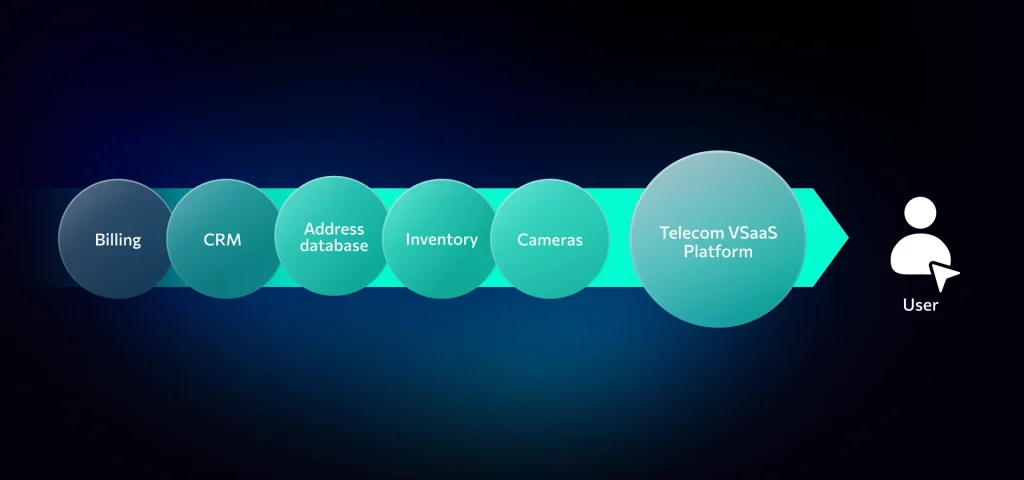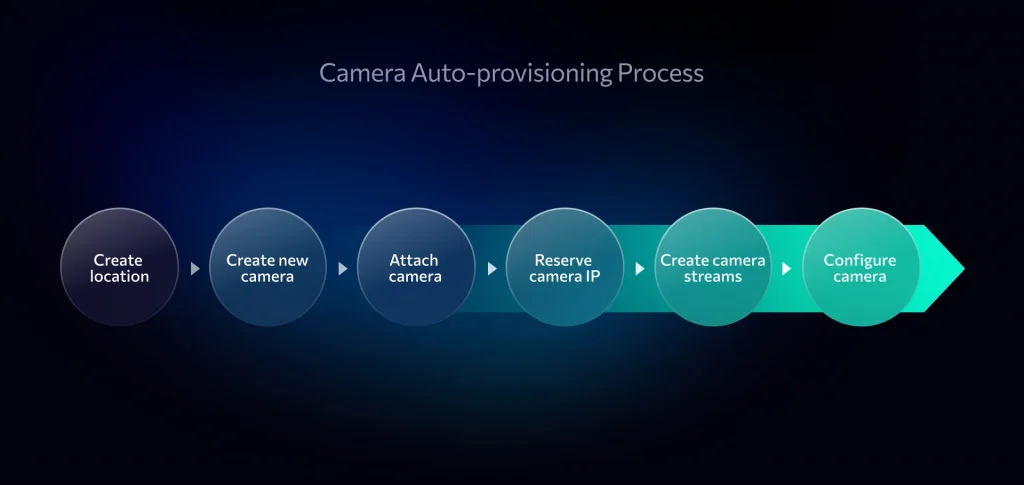How Auto-Provisioning Transforms Video Surveillance in Telecom
As telecommunications companies roll out new services, they face a multitude of challenges. Balancing expansion with agility and rapid service deployment is crucial yet daunting, leaving operators searching for solutions that can streamline their efforts and enhance scalability. The complexity of managing intricate processes drives telecom providers to seek out solutions provided with features which allows flexible and quick implementation. Auto-Provisioning in Video Surveillance can become a key!
One prime example is the core feature of auto-provisioning used in the deployment of cloud video surveillance services. This is a smart, automated system designed to simplify and accelerate the entire process of deploying cloud such type of services. Auto-provisioning enables operators to deliver a ready-to-use service by creating a structured “tree” of customer addresses and inventory locations. Subsequently, cameras are added and configured into the framework. The client can almost immediately start watching the video stream in their account, aggregating all video and analytics data in a single interface.

This article delves into the numerous benefits of auto-provisioning, detailing the processes involved and its significant advantages to operators.
The Benefits of Auto-Provisioning
In the face of the myriad challenges telecom companies encounter as they expand, auto-provisioning emerges as a clear, no-brainer solution. It significantly simplifies the complex landscape of digital Value-Added Services in the telecoms industry by automating key aspects of service deployment and management.

Below are the standout benefits that underscore the value auto-provisioning offers:
Scalability and Cost Reduction
Auto-provisioning automates processes, enabling businesses to grow while reducing costs, making expansion more efficient and sustainable.
Immediate Service Availability
Clients can instantly access services, improving customer satisfaction and loyalty by providing services that are ready to use right away.
Flexibility and Responsiveness
Auto-provisioning technology offers the agility to adapt quickly to market changes, ensuring services stay relevant and competitive.
Complete Process and Infrastructure Control
Telecom Operators gain comprehensive control over every aspect of service delivery, ensuring optimization and alignment with business goals.
Seamless System Integration
The solution integrates smoothly with existing operator systems, enabling efficient management of activities.
Guaranteed Safety and Reliability
High safety and reliability standards ensure operators can offer secure services, building trust and dependability with customers.
How Auto Provisioning for Video Surveillance Services Work
Here’s a breakdown of how it transforms a complex process into something much simpler, ensuring everything runs smoothly from start to finish:

- Creating a Camera Network. It starts by organizing a “tree” of camera locations, requiring a digital database of customer addresses. This database is synced with the Video Management System (VMS), ensuring precise camera placement on the map.
- Adding Cameras to the Inventory. Cameras addition set as “entities” in the system, syncing the customer’s inventory database with the VMS platform. This enables the system to automatically recognize new cameras when they arrive at the customer’s warehouse, using their unique MAC and serial numbers for identification.
- Configuring Camera Profiles. Each camera is assigned a profile that includes video storage duration and its location in the customer’s CRM. This profile is then synchronized with the platform.
- Connecting Cameras to the Network. For a camera to start working, it needs an IP address. Once installed, a camera automatically picks up this address from the network, thanks to DHCP (Dynamic Host Configuration Protocol) and ONVIF profiles, ensuring it’s ready to communicate with the VMS platform.
- Setting Up Video Streams. The system establishes high and standard-quality video streams by ensuring a seamless connection between the media servers and cameras for clear delivery.
- Applying Final Camera Settings. Here applied specific configurations to each camera model, pre-prepared for various types to ensure optimal performance based on design and service plan.
Through these steps, auto-provisioning de-complicates the setup of video surveillance, making it a nearly hands-off process for operators. It speeds up the deployment and guarantees customers a high-quality, reliable service tailored precisely to their needs.
Operational Foundations: The Necessities for Auto-Provisioning
With a clear understanding of how auto-provisioning operates in terms of cloud video surveillance service, it’s essential to pivot towards what this entails for telecom operators.
The success of auto-provisioning hinges not only on the process itself but also on several critical prerequisites that operators must fulfill to harness its full potential:
- At the core of auto-provisioning is a comprehensive digital database that catalogs addresses and locations, including specific entrances or premises. This database plays a crucial role in accurately mapping the placement of surveillance cameras, ensuring full coverage of the intended areas.
- A structured approach to managing new camera equipment is essential for ensuring efficient service deployment. This includes receiving the equipment at the warehouse, distributing it to designated locations, and installing it promptly. Clear, transparent management of this process ensures proper allocation, accountability, and timely setup, reducing potential delays and enhancing the overall efficiency of service delivery.
- The operator’s network must be prepared to handle the demands of video surveillance services. This includes ensuring adequate bandwidth, robust security protocols, and the proper connectivity required for smooth video stream transmission and seamless camera deployment. These technical preparations are essential for maintaining system performance and supporting the efficient operation of surveillance services.
- In addition to technical preparedness, operators require strong internal systems, processes, and regulations to effectively manage the provisioning of services. These systems ensure a smooth, continuous workflow from service request to final delivery, integrating auto-provisioning platforms with CRM and inventory systems for real-time updates and coordination. This alignment enhances efficiency, reduces errors, and ensures that each step of the provisioning optimization, ultimately improving the service experience for customers.
This foundation sets the stage for operators to use auto-provisioning as a strategic asset to facilitate growth and innovation in their video surveillance offerings.
Benefits for Operators Leveraging Auto-Provisioning
Here’s how telecom operators gain from implementing auto-provisioning within their infrastructure:
- Efficient Infrastructure Deployment. Auto-provisioning enables the swift creation and deployment of a telecom operator’s infrastructure, akin to rolling out a “carpet” where services can run seamlessly. This automation in setting up networks and equipment drastically reduces the time it takes to plan and service customers.
- Enhanced Control and Transparency. With auto-provisioning, operators gain unparalleled control over every step of the service provisioning process. From initial creation to final activation, every stage is transparent and manageable. This oversight ensures that operators can fine-tune their services for optimal performance.
- Predictable Service Penetration. The predictability that comes with auto-provisioning is a game-changer. Operators can forecast and track how quick and effective process of adopting services across their infrastructure. This foresight allows for better resource management and strategic planning, ensuring that growth targets are met and customer needs are anticipated and addressed.
- Diverse Service Offerings. Perhaps one of the most significant advantages of auto-provisioning is its ability to democratize service provision. Telecom operators can cater to a broad spectrum of users, delivering mass services across different user categories without delay. Whether it’s residential customers looking for home surveillance solutions or businesses in need of comprehensive security coverage, auto-provisioning facilitates a one-size-fits-all approach that is both efficient and inclusive.
In summary, auto-provisioning for video surveillance services simplifies the technical challenges associated with deploying and managing telecom infrastructure.
Conclusion: The Strategic Advantage of Auto-Provisioning
Auto-provisioning gives telecom operators a fast track to prepare their infrastructure for setting up, running and managing new services. It’s a game-changer that makes it easier to plan for growth and quickly adapt to customer needs. This approach speeds up service delivery and allows telecom companies to offer a broad range of services to different types of customers. In short, auto-provisioning is a key tool for telecom companies looking to stay ahead in a fast-moving industry.
Auto-provisioning is implemented on Aipix VAS for Telecom Platform as one of its cutting-edge features . This gives Aipix customers a powerful tool to manage the complexities of modern network infrastructure. With this capability, Aipix customers can turn potential obstacles into opportunities for growth in their telecom businesses.
Ready to take your business to the next level? Let’s discuss how Aipix can help.





